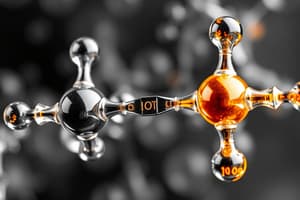Podcast
Questions and Answers
What defines an ionic compound in terms of electronegativity difference?
What defines an ionic compound in terms of electronegativity difference?
Which of the following best describes the Lewis dot structure for hydrogen?
Which of the following best describes the Lewis dot structure for hydrogen?
Which of the following describes the electrical conductivity of ionic compounds when dissolved in water?
Which of the following describes the electrical conductivity of ionic compounds when dissolved in water?
What is the process to draw Lewis diagrams for atoms?
What is the process to draw Lewis diagrams for atoms?
Signup and view all the answers
Which type of bond forms between atoms with an electronegativity difference of 0?
Which type of bond forms between atoms with an electronegativity difference of 0?
Signup and view all the answers
What characterizes a polar covalent bond?
What characterizes a polar covalent bond?
Signup and view all the answers
In the bonding Lewis diagram for sodium and chlorine, what step follows drawing the individual Lewis structures?
In the bonding Lewis diagram for sodium and chlorine, what step follows drawing the individual Lewis structures?
Signup and view all the answers
Which of the following correctly identifies the bond type for Na-Cl?
Which of the following correctly identifies the bond type for Na-Cl?
Signup and view all the answers
Study Notes
Chemical Bonding: Ionic Bonding
- Ionic bonding involves the transfer of electrons between atoms, forming ions.
- Atoms gain or lose electrons to achieve a stable electron configuration (usually a full outer shell).
- Metals tend to lose electrons, forming positive ions (cations).
- Nonmetals tend to gain electrons, forming negative ions (anions).
- The electrostatic attraction between oppositely charged ions forms the ionic bond.
- Ionic compounds are typically solid at room temperature.
- Ionic compounds generally have high melting points.
- Ionic compounds are often soluble in water.
- Ionic compounds conduct electricity when melted or dissolved in water (because ions are free to move).
Lewis Dot Diagrams
- Lewis diagrams depict only the valence electrons of an atom.
- Valence electrons are the outermost electrons involved in chemical bonding.
- Dots are placed around the element symbol, one per valence electron.
- Dots are spread evenly over the four sides of the symbol, and pairing begins only after each side has at least one dot.
- The arrangement of valence electrons helps predict how atoms will bond.
Electronegativity
- Electronegativity measures an atom's ability to attract electrons in a chemical bond.
- Electronegativity follows a periodic trend, with electronegativity increasing across a period and decreasing down a group.
- Fluorine is the most electronegative element.
- Differences in electronegativity determine the type of chemical bond formed.
- A large difference in electronegativity between two bonded atoms favors ionic bonding.
- A smaller difference favors covalent bonding.
Properties of Ionic and Covalent Compounds
| Property | Ionic Compound | Covalent Compound |
|---|---|---|
| State at room temperature | Typically solid | Can be solid, liquid, or gas |
| Melting point | High | Low |
| Electrical conductivity as a liquid | Conducts electricity | Does not conduct electricity |
| Solubility in water | Often soluble | Can be soluble or insoluble |
| Electrical conductivity when dissolved in water | Conducts electricity | Can conduct or not conduct electricity |
Bonding Between Atoms
- Atoms combine to form molecules to gain stability.
- When two atoms combine, the valence electrons interact.
- A chemical bond forms if the new arrangement of valence electrons has lower energy than the original arrangement.
- Ionic bonding is influenced by the difference in electronegativity values (a measure of an atom's ability to attract electrons).
Studying That Suits You
Use AI to generate personalized quizzes and flashcards to suit your learning preferences.
Related Documents
Description
Explore the concepts of ionic bonding and Lewis dot diagrams in this quiz. Understand how electrons are transferred to form ions and visualize valence electrons through Lewis structures. Test your knowledge on the properties and behaviors of ionic compounds.




